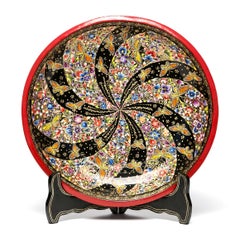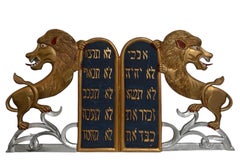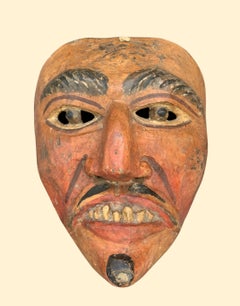Maria Dolores Tapia Talavera More Art
to
1
Overall Width
to
1
1
1
1
335
231
205
121
Artist: Maria Dolores Tapia Talavera
14'' Batea perfilada Wood carving Alebrije Sculpture Mexican Folk Art
By Maria Dolores Tapia Talavera
Located in Jesus del Monte, MX
FREE SHIPPING TO WORLDWIDE!
Artisan: Maria Dolores Tapia Talavera
Fine wood plate, gold-platted with resin material. Decorated with flora and fauna, morning glories, painted with na...
Category
2010s Folk Art Maria Dolores Tapia Talavera More Art
Materials
Wood, Lacquer
Related Items
Rare Folk Art Hebrew Judaica Carved Gilded Wood Lions Torah Synagogue Sculpture
Located in Surfside, FL
Paint and gold paint on wood
Circa early to mid 20th century.
This is not signed
A treasure from a proud congregation. It is a hand-carved wooden sculpture showing the Tablets of the Law flanked by two Lions of Judah. Their paws held the tablets. Their roaring mouths faced outward, protecting the commandments from threats. In a foliage design with gold and silver paint.
Circa 1920-1940's. This Neoclassical, Judaic, Art Deco, Egyptian revival, Shul, Aron Kodesh hand carving, wood with gilding, Hebrew lettering ten commandments sign sculpture, was produced probably in New York.
There was a show at the Folk Art Museum titled “Gilded Lions and Jeweled Horses: The Synagogue to the Carousel” That featured these antique magnificent pieces. From gilded lions to high-stepping horses, the sacred to the secular, and the Old World to the New, “Gilded Lions and Jeweled Horses: The Synagogue to the Carousel” traces the journey of Jewish woodcarvers and other artisans from Eastern and Central Europe to America and the unsung role they played in establishing a distinct Jewish culture in communities throughout the United States. The exuberant artworks stand as a testament to a history of survival and transformation and provide a surprising revelation of the link that was forged between the synagogue and the carousel as immigrant Jewish artists transferred symbolic visual elements into this vernacular American idiom. The first major study of this important aspect of the Jewish contribution to American folk art, the exhibition features approximately one hundred artworks and objects, including rare documentary photographs of Eastern European synagogue arks and carved gravestones, sacred carvings, papercuts, and carousel animals. Some of these same Jewish European carvers worked on Coney Island amusement park rides and carousel horses and other carnival and circus carvings.
Category
Early 20th Century Folk Art Maria Dolores Tapia Talavera More Art
Materials
Metal
$3,600
H 20.25 in W 38 in D 1 in
Guatemala. Maschera di Baila de la Conquista. Inizio XX secolo
Located in Firenze, IT
Questa maschera guatemalteca del inizio del XX secolo, scolpita in legno e utilizzata per la danza della Riconquista (Baila de la Conquista) , raffigura vividamente un uomo europeo, ...
Category
Early 20th Century Folk Art Maria Dolores Tapia Talavera More Art
Materials
Wood, Intaglio
$239 Sale Price
20% Off
H 7.49 in W 5.71 in D 4.34 in
African art tribal maternity figure, Lobi peoples Ghana - Ivory Coast
Located in Norwich, GB
A delightful African maternity figure from the Lobi peoples of the Ivory Coast/Ghana. With a serene yet feisty expression, the mother is carry...
Category
Mid-20th Century Folk Art Maria Dolores Tapia Talavera More Art
Materials
Wood
$386
H 7.88 in W 2.76 in D 2.37 in
European 19th Century Folk Art Painted Wooden Hope, Bridal Wedding Chest
Located in Cotignac, FR
Early 19th century European folk art painted wood wedding, hope or bridal chest.
A superb example of a European hope or wedding chest in remarkable condition Of characteristic dome ...
Category
Early 19th Century Folk Art Maria Dolores Tapia Talavera More Art
Materials
Iron
$2,152
H 11.03 in W 17.72 in D 11.82 in
Wool Felt Applique Israeli Folk Art Lion Signed Tapestry Kopel Gurwin Bezalel
By Kopel Gurwin
Located in Surfside, FL
This tapestry depicts a Lion, In Hebrew Mazel Aryeh (the Zodiac symbol Leo,) all handmade. woven and stitched.
Kopel Gurwin (Hebrew: קופל גורבין) (1923–1990) was an Israeli tapest...
Category
20th Century Folk Art Maria Dolores Tapia Talavera More Art
Materials
Wool, Felt
Coca-Cola sign - Unique Hand-Painted Wood Coke Sign - "Drink Coca-Cola" c 1950s
Located in New York, NY
A vintage, one of a kind hand painted wooden sign ca. 1950s or 1960s for Coca-Cola Company. Beautifully painted and rendered image of a classic cola filled soda glass in hand reading...
Category
Mid-20th Century Folk Art Maria Dolores Tapia Talavera More Art
Materials
Wood, Mixed Media
$3,500
H 57 in W 42 in D 0.5 in
Wedding Chest of Corinne de Blaru, French 19th Century Folk Art Painted
Located in Cotignac, FR
Vintage French folk art, Early 19th century, painted wood wedding, hope or bridal chest, for the wedding of Charles Herbert Frederic and Corinne de Blaru in 1848. The names and dates...
Category
Early 19th Century Folk Art Maria Dolores Tapia Talavera More Art
Materials
Iron
$2,127
H 11.03 in W 17.72 in D 11.82 in
Vintage wood face mask, dark brown
Located in San Diego, CA
Vintage wood mask. The edge undulates and is lightweight. Date and artist unknown.
Category
20th Century Folk Art Maria Dolores Tapia Talavera More Art
Materials
Wood
Scraps and Scribbles, Contemporary Quilt
By Bethan Ash
Located in Brecon, Powys
A madcap assortment of shapes randomly applied form the root of this colourful design. Which has been inspired by my thrifty nature and love of using left over scraps of fabrics from...
Category
2010s Folk Art Maria Dolores Tapia Talavera More Art
Materials
Fabric
Embroidered Miao Baby Carrier Textile
Located in Chicago, IL
The connection between love and embroidery is nowhere stronger than among the minority peoples of China. Hand-stitched by a mother herself or gifted by the women in her family, the t...
Category
Early 20th Century Folk Art Maria Dolores Tapia Talavera More Art
Materials
Cotton, Silk, Thread
"Wood Carving, " Wood Painted in Yellow, Red, Blue, & Green made in Indonesia
Located in Milwaukee, WI
This wood carving was created by an unknown Indonesian artist. It is approximately 17" tall by 7" wide. It was painted with abstract designs in primary colors.
Category
20th Century Folk Art Maria Dolores Tapia Talavera More Art
Materials
Wood
Framed Hmong Appliqué Textile Fragment
Located in Chicago, IL
Dating to the mid-20th century, this colorful Hmong textile is a classic example of the appliqué technique used for the traditional cloth known as paj n...
Category
Mid-20th Century Folk Art Maria Dolores Tapia Talavera More Art
Materials
Textile
Maria Dolores Tapia Talavera more art for sale on 1stDibs.
Find a wide variety of authentic Maria Dolores Tapia Talavera more art available for sale on 1stDibs. You can also browse by medium to find art by Maria Dolores Tapia Talavera in lacquer, wood and more. Not every interior allows for large Maria Dolores Tapia Talavera more art, so small editions measuring 14 inches across are available. Customers who are interested in this artist might also find the work of Tom Carapic, Andrea Doss, and Kira Yustak. Maria Dolores Tapia Talavera more art prices can differ depending upon medium, time period and other attributes. On 1stDibs, the price for these items starts at $800 and tops out at $800, while the average work can sell for $800.


